Fish descenders and vent tools are tools used to help release fish that have been brought up from depths over 50 feet deep. Using a fish descender is the preferred way to release a fish although it is a bit more work. Fish vent tools use a sharp hollow needle to puncture the swim bladder which releases the air within the swim bladder and stomach. This does cause damage to the fish which can result in the area becoming infected and the fish dying.
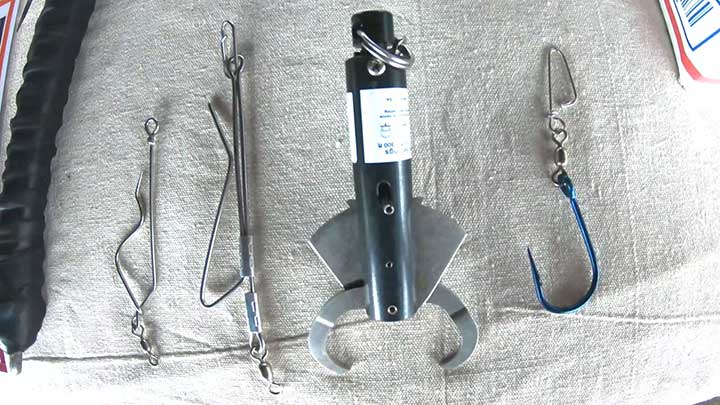
A fish descended uses a clamp or hook in addition to large weight to bring the fish back to a deep depth. Even fish that have their eyes bulging and stomach coming out of their mouths can still live if properly released. It is important to try and minimize the amount of deep fish caught that are not going to be kept to eat. In Alaska, it is illegal to use a vent tool on rockfish and it is required that every boat have a rockfish release device on the boat which is also called a fish descender. It does not have to be a particular kind but needs to be readily available and function properly.
A fish descender can be used on a regular fishing rod, electric reel, or downrigger. Large reels are needed when releasing large yelloweye and large grouper as it is common to need three or more pounds of weight to get the fish to sink. This is because the small amount of air in the fish expands significantly as it is brought up from deep depths. Now, let us look at the different kinds of fish descenders.
Fish Descenders and Rockfish Release Devices
Seaqualizer Fish Descender
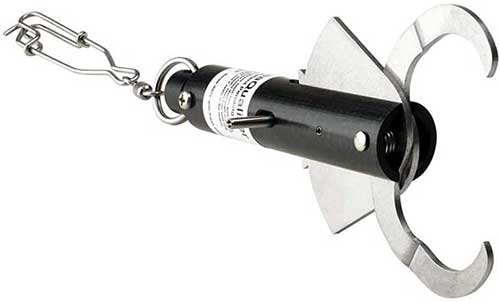
The Seaqualizer is becoming the most popular rockfish release device used in Alaska. It works by clamping the top or bottom lip of the fish with the lip grippers. The other side is connected to a weight or downrigger ball. Each device can be released at three different depths, 30, 50, and 70 feet for the shallow device, 50, 100, 150 feet for the standard model, and 100, 200, 300 feet for the deep model. There are three groves in the back that adjust the release depth. All the way out is the shallower setting and pushed in is the deepest setting.
A small rockfish in 100 feet of water or less will probably only need a 1 pound weight sink. Large yelloweye rockfish and snowy grouper caught in 200 feet or more will likely take 3-5 pounds of lead weight to sink. If the depth setting is not deep enough the fish will rise back to the surface and die. It is hard to recover the fish again when on anchor. The fish should be sent down as close as possible to the original depth. Here is a chart showing some of the types of rockfish.
The video above shows how to use a Seaqualizer deep water fish descender. It has an underwater video of the rockfish being brought back to depth. This helps demonstrate that fish with serous barotrauma such as an inverted stomach, bulging eyes, and an inflated swim bladder can survive if properly released. This has been done in many videos showing that when the expanded air is compressed back to its original size the fish can survive. Venting a fish brought up from deep depths would not be enough to allow the fish to swim back down. That is one reason why a fish descender must be used.
Sheldon Fish Descender

The Sheldon release device is another popular type of fish descender, especially for fish under 5 pounds. It works by adding a 1-3 pound lead weight to one end. The fish lip is placed on the hook and the weight brings the fish deep. After a long count depending on the depth, the rig then starts to be brought back up, and the fish slides off the hook. At this point, the air within the fish will be back to a small volume, and the fish should be fine.
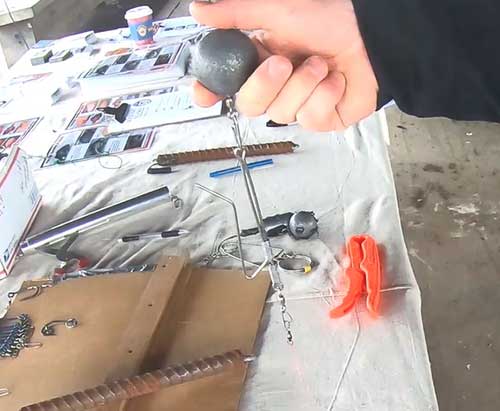
The picture above shows a fish descended with a lead ball weight attached. On the other end is a swivel which has the line coming from the fishing rod.
The video below shows a fish with barotrauma being released with a deepwater release device. This is a large yelloweye rockfish and three pounds of weight is needed to sink the fish.
Crate Box Fish Descender
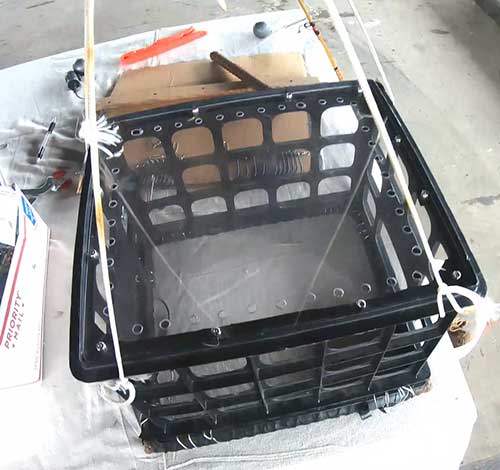
This is a unique way to build a custom fish descended. It is a milk crate with a clear plastic top. On the bottom, the rebar is attached to add weight. A rope is used to lower and raise the crate. This is nice as it is a dedicated system to release rockfish. Disadvantages are that it takes up room in the boat and can be lots of work to hand pull this every time a rockfish is caught especially at deep depths.
Rock Lee’s Fish Descender
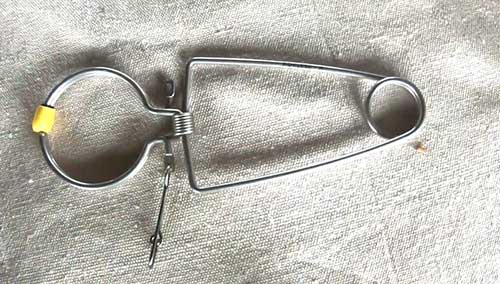
Rock Lee’s Fish descended is a great way to release rockfish. The only problem is they can be difficult to find for sale. It works by attaching the fish to the front grippers, a weight to the bottom clip, and a fishing line to the top clip. Once the fish has reached the desired depth pulling up sharply on the line opens the front gripper so the fish comes off.
The video below is a great example of how many types of fish descenders work. A GoPro underwater camera is used by the anglers to show the fish recovering as they are brought back to depth. It also shows them swimming away safely. In the video, the homemade inverted jig, milkcrate, Rock Lee’s device, Seaqualizer, and Sheldon fish descender are all shown.
Fish Saver Pro
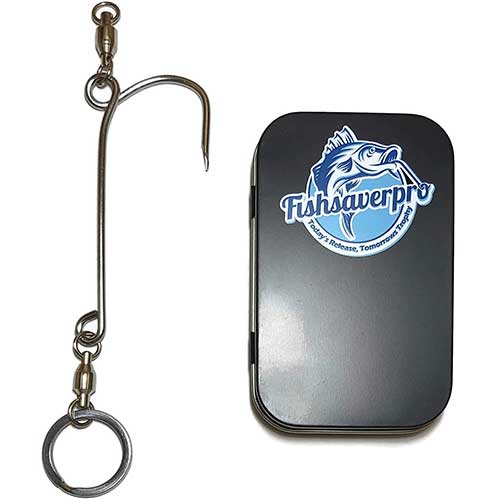
Fishsaverpro is a simple rockfish release device. The weight is attached to the bottom loop and the line is tied to the top ball bearing swivel. The hook itself does not have a barb which allows the rockfish to easily slide off once the fish descender reaches the desired depth. This is a simple device but works well. It is a similar design to just using a hook or inverted jig. However, having a swivel to attach the top line is nice. The rig without weight is about 6 inches in length so this is a larger setup than just using an inverted hook with a snap swivel. A snap swivel can be added to the bottom loop to make adding and removing weight be an easier process.
Homemade Inverted Jig Fish Descender
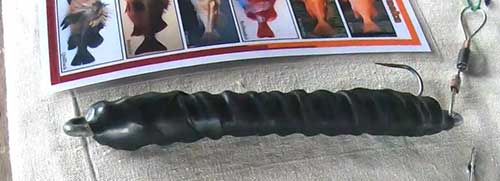
This is a homemade inverted jig made with rebar, a hook, and stainless steel cable. The large piece of rebar is the weight that makes it sink. Anglers can also use a large jig and tie the line to the u-shape in the hook. The barb should be removed from the hook so the fish will slide off easily. Rebar is not stainless steel so it can leave rust marks on the boat and should be rinsed with fresh water. This jig is sealed in plastic to help prevent this. Having an actual fish descender is better but if it gets lost using a jig is a quick way to improvise and safely release fish that are caught in deep water.
Fish Lip Gripper Custom Fish Descender
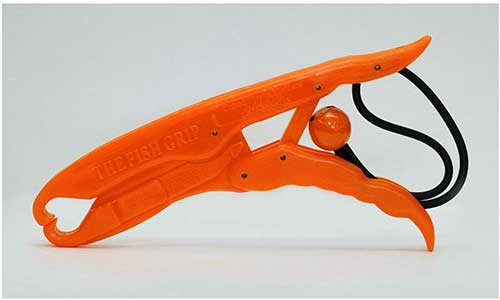
A fish lip gripper can be used to make a nice custom fish descended release device. This is done by attaching the line to the top handle, weight to the bottom handle, and rubber bands around the handle if the gripper opens too easily. It works by securing the fish in the lip gripper and sending it down near the depth the fish was caught at. Then the angler pulls up on the rod and the grippers are forced opened and the fish is safely released. It takes a little work to modify the lip gripper but this is a quick and easy way to release rockfish, grouper, and snapper.
The video below shows the custom fish descender in action. It is made by Oregon Fish and Wildlife. Several different types of rockfish are released using the device. An underwater camera is used to show the fish recovering from the barotrauma as it is brought back to depth. In some cases, the eyes are popping out of the head, and as the fish is brought back to depth the eyes and inverted stomach go back into the fish’s body and it swims off.
Fish Vent Tool
A fish vent tool may seem like a good tool to use to release fish. These devices use a hollow needle to puncture the fish in the swim bladder to release expanded air within the fish. If only the swim bladder is inflated and not other organs such as the eyes, this method can allow the fish to swim back to depth and some anglers think the fish is going to be ok. However, studies have shown this is often not the case. Even a small puncture can cause an infection resulting in the fish dying.
Alaska Fish and Game made it illegal to vent rockfish when fishing in Alaska. It is required that a fish descender is on the boat and used when fish are caught in deep water. In federal water from North Carolina to Florida anglers are required to have a fish descended on the boat as well and are not to use a vent tool. The fish descender must be readily available and have at least 16 ounces of weight to meet the Federal requirements. However, more weight is often needed.
Anglers Choice Vent Tool

Fish vent tools are one-way that anglers can remove excess air from a fish that is brought up from a deep depth. The hollow needle is inserted into the swim bladder by lifting a scale and then puncturing the fish. Studies that were done in the gulf showed that vent tools were somewhat helpful with survival rates. However, most people now agree that using a fish descender rather than a vent toll leads to much higher survival rates of fish. I would strongly discourage anglers from using vent tools when releasing fish. It is the lazy way to do it and leads to a high mortality rate of the fish. It is much better to use a fish descender and bring the fish back close to its original depth for a proper release.
Yandia Fish Venting Tool
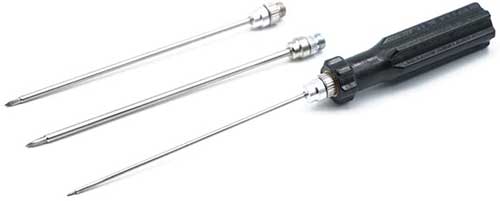
This vent tool has a handle the looks like a screwdriver. The needles are between 5 and 6-inches in length and are made of stainless steel. Each needle is hollow in order to vent the air from the fish. To properly vent a fish the swim bladder needs to be punctured with the needle. Never puncture the stomach, intestines, or eyes that might also be bulging from the fish. The needed should be worked under the scales and into the swim bladder. It should remain in the fish until all the air is released.
That is the proper way to use a vent tool. However, the fish survival rates are not good when a vent tool is used. It is much better to use a fish descender to bring the fish back to depth. This takes a little more time but is much better for the conservation of gamefish.
Frequently asked Questions
What is a fish descender?
A fish descender is a weighted device that is used to bring a fish back to depth. Some fish will have expanded air inside them when reeled in from a depth greater than 50 feet. Using a fish descender gives the fish the best chance of survival. Small fish under 5 pounds caught in under 100 feet of water depth can typically be sent back down with a 1 pound weight. Larger fish caught deeper can require significantly more weight to sink. Sometimes sending the fish down using a Seaqualizer on a downrigger ball is the best option.
What is a fish vent tool?
A fish vent tool is a hollow needle that can puncture the swim bladder of the fish releasing most of the air inside the fish. This is done so the air inside the fish that expands when bringing it up from deep water can be released. This has limited effectiveness though and a fish descender is a better device to use. Some studies show that venting the fish and then using a fish descender is best. In my opinion, it is best to not puncture the fish with a vent tool and release it close to the depth it was caught at using a fish descender.
Do fish Descenders actually safely release fish?
Yes, deepwater release studies have shown that fish have over a 98 percent survival rate when a fish descended is used in water depths up to 236 feet deep. Some people claim they do not work cause fish re-surface after using the device. The device did not work properly if the fish surfaces again, this is true. However, this is likely due to the fish not be brought back deep enough so it was still too positively buoyant and could not swim back to the bottom.
What is better to use a fish descender or vent tool?
Based on the research studies I reviewed it is much safer for the fish if a fish descended is used. A venting tool can have higher survival rates than not using a vent tool. However, for fish caught at deep depths over 100 feet with significant signs of barotrauma, a fish descender is needed. In Alaska and in federal waters in the south Atlantic ocean, it is required to use a fish descender and not a vent tool.
Do all types of fish need to be sent back with a fish descender?
All types of fish do not need to be vented or released with a fish descender. Halibut and flounder have a swimbladder but it does not typically have enough air in it to prevent the fish from returning to the bottom. Some types of fish such as sharks and rays do not have swim bladders. If you catch a fish and it is floating at the surface after release chances are that it has air built up within it that is not allowing the fish to swim down. Most fish that are caught deeper than 60 feet will need to be released with a fish descender. Common species that suffer from barotrauma include walleye, tilefish, snapper, grouper, and rockfish.
References
1) Wilde, Gene. (2009). Does Venting Promote Survival of Released Fish?. Fisheries. 34. 20-28. 10.1577/1548-8446-34.1.20.
2) Hochhalter, Samuel & Reed, Daniel. (2011). The Effectiveness of Deepwater Release at Improving the Survival of Discarded Yelloweye Rockfish. North American Journal of Fisheries Management. 31. 852-860. 10.1080/02755947.2011.629718.
3) Fisheries, NOAA. “NOAA Fisheries Announces Gear Modifications for the Snapper-Grouper Fishery.” NOAA, 12 June 2020, www.fisheries.noaa.gov/bulletin/noaa-fisheries-announces-gear-modifications-snapper-grouper-fishery.
4) Possessing Venting Tools and Descending Devices When Fishing for Reef Fish, Gulf of Mexico Fishery Management Council, 25 May 2017, gulfcouncil.org/wp-content/uploads/E-5-Options-Paper-for-Venting-Tools-and-Descending-Devices-1.pdf.
Captain Cody has worked on charter fishing boats in the Florida Keys, Virgin Islands, and Alaska. Growing up in Pennsylvania Cody has also done extensive freshwater fishing including bass fishing tournaments. Cody strives to provide detailed information about the best fishing gear and tactics to help both novice and experienced anglers have a more productive and enjoyable time on the water. Cody also has a background in aerospace engineering and neuroscience but really only takes pride in being good at one thing and that is fishing!
